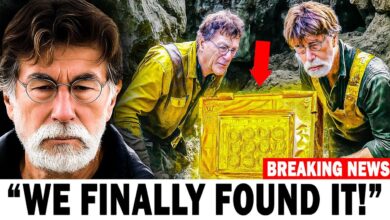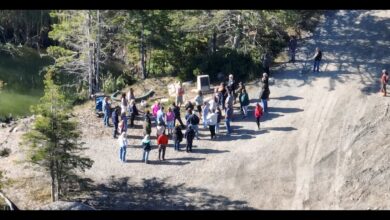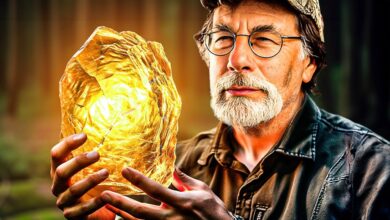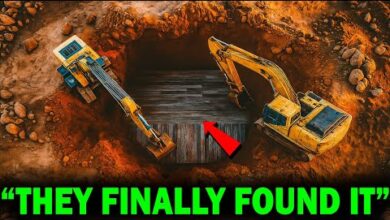The Curse of Oak Island: 17th Century French Relic Discovered (Season 11)
The Curse of Oak Island: 17th Century French Relic Discovered (Season 11)

[narrator] Rick Lagina and Gary
Drayton are searching an area
where they have made some
of the oldest discoveries
ever documented
not only on Oak Island,
but in all of North America.
-You’re about due for a coin.
-I am overdue a coin.
Yay! It’s a coin.
[narrator] One week ago,
Gary, along with Rick,
Marty, and their
partner Craig Tester…
[man] This is clearly
Roman design.
Roman, baby!
[narrator] …unearthed four
ancient coins in this area,
making a total of five
that have been discovered
in the past year.
Incredibly,
three of these coins
have been determined
by numismatist Sandy Campbell
to date between 500 AD
and 300 BC
and to also be
of Roman origin.
[Rick]
Lot 5 is a complete mystery.
It’s a mystery in terms of
the manmade constructs,
the kinds of artifacts that have
come out of the ground.
It’s mystifying.
[beeping]
[Gary] Gotta come out
’cause I don’t know what it is.
-Right in the middle.
-[Rick] Okay.
[suspenseful music playing]
Think that’s it.
[beeping]
-Sounds a little bit better now.
-[Rick] Mm-hm.
[beeping]
[beeping continues]
[Rick] Come on, be something.
[Gary] Some kind of strap.
And this looks like it goes down
like to a point there and then
down there, it’s almost
like a decorative strap.
[Rick] Hm. It could be something
broken off of something else.
Yeah, you know,
a lot of these straps
were around boxes
or chests.
That would be cool.
There you go.
I would imagine
this has something to do
with whatever
that depression is over there.
[narrator] A strap?
Possibly from a box? Or chest?
Could Gary by correct
that it might be related to
the nearby circular depression?
Or might it
possibly be connected
to the numerous Roman coins
that the team has found
in this area?
[Gary] That CT scanner
will give us a good view.
At that point, you no longer
have to speculate,
as to what it is, you
speculate as to its purpose.
Yeah.
[Rick] The information that Emma
and the CT scanner provide
might be very highly revealing
what it means
to the feature on Lot 5.
You can’t argue
with the science.
It will be what it will be
and hopefully that information
connects up
to the greater mystery.
[Gary] Let’s see if we can
rustle up another find.
[beeping]
[beeping continues]
We’ve got something
in this area.
Let me just brush the stuff away
and take another swing.
[beeping continues]
Not sure what that is.
It’s this side of that root.
[grunts] Oh, wow.
It’s not the easy one.
[beeping]
I think it’s here.
-It could be…
-[beeping]
-…iron.
-[beeps]
It is iron.
[beeping continues]
Chunky iron. Look at that.
What the heck is that?
No idea.
-Heavy?
-[Gary] Oh yeah, it’s heavy.
I believe this is some kind
of fastener by the look of it.
Mm-hmm.
[Gary] And it could be
a rosette-type fastener.
It’s old.
And a lot of that
old, hand-forged iron
tends to be on the heavy side.
Well, we’re close to the most
prominent feature on Lot 5.
Right? If there was a structure,
what do you need to put
a structure together
but fasteners, right?
Yeah.
[Rick] Why are we finding
bits of iron
on lots where
significant finds were made
is very strange,
given the fact that
iron was a valuable resource
and you wouldn’t just waste it.
So what is the explanation as
of yet? I don’t think we know.
And these are the type of things
that you show to Carmen
and you never know, it could be
more than what we believe it is.
-Adding to the story on Lot 5.
-Yeah.
Emma’s gonna be busy.
[narrator]
The following morning…
[Rick] Here he is. How are you?
-Hey, Carmen, how are you?
-[Carmen] Not too bad.
[narrator] Rick Lagina
and members of the team
meet with blacksmithing expert
Carmen Legge
at the Oak Island
Interpretive Centre.
As you see, we’ve got
a bunch of items here
that have been recovered
from a specific lot of interest.
I see that.
[narrator] Carmen has been
invited to examine
some of the artifacts
that were recently discovered
on Lot 5.
I think I’ll go over
to this one here now.
I’ll give you a bit of context
on the chunky piece of iron,
found on Lot 5,
and when it first came up,
I knew it was old
because it’s nice and heavy.
And it just had a feel
like it was
some kind of broken tool to me
or a fastener.
It’s very old.
This is much older.
Could we have a scan of that?
-I need to see the head.
-The head? Yeah.
[Carmen] From what I see there
on the head,
it looks like it was
the broken end off something.
It looks to me like it could be
some sort of a chisel.
Yes, this could be a tool
that could be used
for mining or tunneling.
Wow.
With the size that you’ve
got in your hand,
how much bigger
would it have been?
Length-wise, we’re probably
looking at a foot.
And for shorter than that,
again,
it might not be long enough to
fulfill the purpose
of what you want it for.
-Could we see the metallurgy?
-Sure thing.
No modern elements.
Potassium and calcium.
So it’s… It’s an older metal.
That’s good.
So got a lot of little fasteners
and tools, and more to come.
Yeah, I’ll go
with this one here next.
It looks like a bowtie strap.
-You can see the bowtie?
-Yeah. You can see–
-What’s a bowtie strap?
-It was a decorative piece
that had decorations
to be narrow-wide, narrow-wide,
all the way around
to decorate a chest.
Oh, so, specifically
chest decorations?
-Yeah, wooden boxes and chests.
-Okay.
That’s exceedingly interesting.
Is there a cultural influence?
Yes.
French.
-Really?
-Yeah.
Wow!
[narrator] A decorative strap
from a chest?
One that is not only possibly
a French origin,
but may also predate
the 17th century?
If so?
Who brought it to Oak Island?
We found important artifacts
that have been French.
We can’t forget the lead cross
where the testing indicated
that the lead came from
the southern part of France.
Yeah, it doesn’t get
any better than that.
It’s curious that this stuff
is found near an area
on the Zena map
that is a French map
that is a possible location
for a hatch.
[narrator] In 2016,
the late author
and researcher Zena Halpern
presented maps of Nova Scotia
and Oak Island
featuring French writing
and what she believed
had been created between
the 12th and 14th centuries
by members
of the Knights Templar.
This led Zena to theorize
that Oak Island
had been visited numerous times
by the Templars
and related organizations
such as the Freemasons
in order to hide
sacred valuables.
Is it possible that
the discoveries made by Rick,
Marty, and their team
such as the lead cross
and the numerous finds
on Lot 5
that predate the discovery
of the money pit
offer mounting evidence
that Zena’s theory is true?
[Rick] We have long puzzled
about the possibility
that these French items,
the lead cross
and Zena’s Map were associated
with some depositional work.
I have always believed that
this work on Oak Island,
the original depositional work
was started incredibly early.
We just have to fill
in the gaps more precisely,
more accurately, more definitively, but…
it’s very interesting.
[Carmen] The artifacts you’ve
shown me over the years
is very unique.
There’s artifacts coming
out of Oak Island
that I haven’t seen
anywhere else.
That’s the reason
for this type of analysis.
What we’re trying to do
is come to an understanding
of what the item represents
in terms of the complexity
of this story on Oak Island.
It’s not a simple process.
It makes me
want to get back to Lot 5
and find some more.
Well, let’s have at ‘er.
That’s why we have
a lot more to dig.
We have a lot more to excavate.
All I can say, Carmen, is,
thank you, appreciate it.
[Carmen] See you later.




